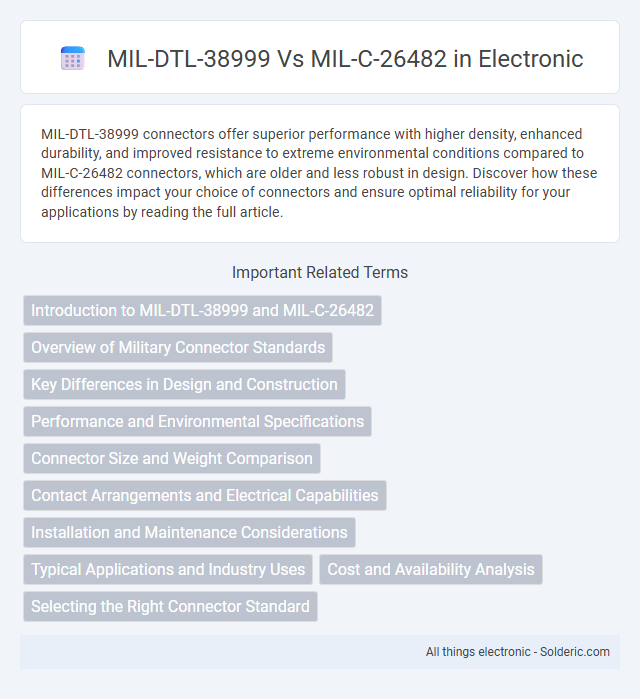MIL-DTL-38999 connectors offer superior performance with higher density, enhanced durability, and improved resistance to extreme environmental conditions compared to MIL-C-26482 connectors, which are older and less robust in design. Discover how these differences impact your choice of connectors and ensure optimal reliability for your applications by reading the full article.
Comparison Table
| Feature | MIL-DTL-38999 | MIL-C-26482 |
|---|---|---|
| Connector Type | Circular, high-performance, rugged | Circular, lightweight, general-purpose |
| Application | Military & aerospace, high-reliability environments | Military, aerospace, data & power transmission |
| Contact Types | Power, signal, coaxial, fiber optic | Signal and power contacts |
| Durability | 500+ mating cycles | 300 mating cycles |
| Environmental Resistance | Sealed, corrosion-resistant, vibration-proof | Sealed, corrosion-resistant |
| Size Range | Multiple shell sizes, smaller and compact designs | Fewer shell sizes, standard sizes |
| Weight | Moderate to heavy-duty | Lightweight, for aircraft wiring |
| Standards Compliance | Updated MIL-DTL series, AS85049 derivative | Legacy MIL-C standards, superseded in many cases |
| Typical Use Cases | High vibration, harsh environments, critical systems | Less demanding, aircraft wiring harnesses |
Introduction to MIL-DTL-38999 and MIL-C-26482
MIL-DTL-38999 connectors are advanced circular connectors designed for high-density, critical military and aerospace applications, offering superior environmental resistance and electrical performance. MIL-C-26482 connectors, older cylindrical connectors, provide reliable connections but with lower durability and sealing capabilities compared to MIL-DTL-38999. Your selection between these standards impacts system reliability and compatibility within rugged environments.
Overview of Military Connector Standards
MIL-DTL-38999 connectors provide high-performance, environmentally resistant solutions ideal for demanding military applications, offering advanced multi-fiber and power configurations with superior durability. MIL-C-26482 connectors, known for their circular, bayonet-style coupling, deliver reliable performance in less extreme environments but with more limited sealing and vibration resistance. Both standards specify robust military-grade connectors, but MIL-DTL-38999 emphasizes enhanced sealing, shock, and vibration resistance suitable for modern defense systems.
Key Differences in Design and Construction
MIL-DTL-38999 connectors feature advanced design with improved environmental sealing, higher contact density, and enhanced durability compared to MIL-C-26482 connectors. The MIL-DTL-38999 series employs composite or metal shells with multiple keying options and a bayonet coupling mechanism, while MIL-C-26482 typically uses cylindrical shells with screw coupling. Your choice impacts system reliability and performance, as MIL-DTL-38999 supports more demanding aerospace and military applications with superior mechanical and electrical characteristics.
Performance and Environmental Specifications
MIL-DTL-38999 connectors provide superior performance with enhanced resistance to extreme vibrations, temperature ranges from -65degC to +175degC, and improved electromagnetic interference shielding compared to MIL-C-26482 connectors, which are rated for -55degC to +125degC. MIL-DTL-38999 also meets more stringent environmental specifications, including better sealing against moisture, dust, and chemicals, making it ideal for harsh aerospace and military applications. Your choice will depend on the required durability and environmental resilience, with MIL-DTL-38999 often favored for high-performance, mission-critical systems.
Connector Size and Weight Comparison
MIL-DTL-38999 connectors are generally larger and heavier compared to MIL-C-26482 connectors due to their robust design intended for high-performance and harsh environments. MIL-DTL-38999 connectors offer superior environmental sealing and mechanical strength, which results in increased size and weight relative to the more compact and lightweight MIL-C-26482 series. The MIL-C-26482 connectors are optimized for applications requiring smaller connector size and reduced weight, making them suitable for less demanding conditions where space and mass constraints are critical.
Contact Arrangements and Electrical Capabilities
MIL-DTL-38999 connectors offer higher contact density with more varied contact arrangements, supporting multiple shell sizes and insert configurations for complex wiring needs. These connectors provide superior electrical capabilities, including higher current ratings, better resistance to vibration and corrosion, and improved shielding for electromagnetic interference compared to MIL-C-26482 connectors. MIL-C-26482 connectors typically feature fewer contact arrangements and lower electrical performance, making MIL-DTL-38999 the preferred choice for demanding military and aerospace applications requiring robust electrical connections.
Installation and Maintenance Considerations
MIL-DTL-38999 connectors offer superior installation and maintenance benefits compared to MIL-C-26482, with enhanced sealing and reliability in harsh environments that reduce downtime and maintenance frequency. These connectors feature quicker engagement and disengagement mechanisms, enabling faster installations and easier field servicing, which saves time and effort. Your choice of MIL-DTL-38999 ensures more efficient maintenance cycles and robust performance for demanding aerospace and military applications.
Typical Applications and Industry Uses
MIL-DTL-38999 connectors are widely used in aerospace, military, and industrial applications requiring high-density, rugged, and reliable connectivity, such as in aircraft avionics, ground vehicles, and communication systems. MIL-C-26482 connectors are commonly found in less demanding military and commercial applications, including tactical radios, sensors, and ground support equipment, where lower weight and smaller size are important but extreme environmental resistance is not critical. Your choice between these connector types should consider the specific environmental conditions, mechanical stress, and reliability requirements of the application.
Cost and Availability Analysis
MIL-DTL-38999 connectors offer higher performance and durability but come at a significantly higher cost than MIL-C-26482 connectors, making them less accessible for budget-sensitive applications. MIL-C-26482 connectors are more widely available, benefiting from established production lines and broader supplier networks, which reduces lead times and procurement expenses. Cost analysis reveals MIL-C-26482 as a cost-effective solution for standard military and aerospace use, whereas MIL-DTL-38999 is preferred for critical, high-reliability systems despite its premium price and limited availability.
Selecting the Right Connector Standard
Selecting the right connector standard depends on your specific application requirements, including environmental conditions and signal integrity. MIL-DTL-38999 connectors offer superior durability, higher density, and better performance in harsh environments compared to MIL-C-26482, which is typically used for lighter-duty applications with lower environmental stresses. Choosing MIL-DTL-38999 ensures enhanced reliability for critical military and aerospace systems where ruggedness and longevity are paramount.
MIL-DTL-38999 vs MIL-C-26482 Infographic

 solderic.com
solderic.com